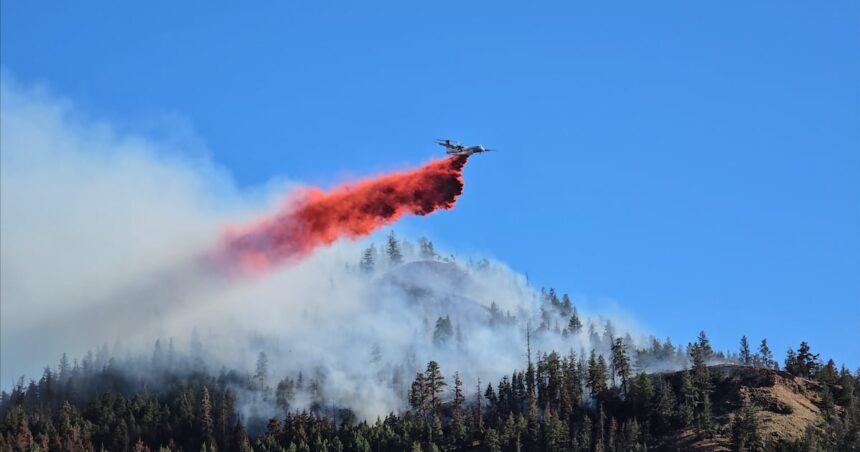A fast-moving wildfire erupted near Princeton, British Columbia late Saturday, forcing hundreds of residents to abandon their homes as flames threatened the eastern edge of the community, including the local golf course. The blaze, which began around 5:30 p.m. in steep terrain just two kilometers from town, has already consumed approximately 210 hectares and continues to expand under challenging weather conditions.
“We’ve issued a mandatory evacuation order for 320 properties in Princeton’s east side,” said Emergency Operations Director Carolyn Barker during a hastily arranged press conference. “The combination of high temperatures, low humidity, and gusty winds has created what our fire teams are calling a perfect storm for rapid fire spread.”
The BC Wildfire Service has deployed eight air tankers, three helicopters, and over 40 ground personnel to battle the blaze, which witnesses describe as producing flames visible from several kilometers away. The Princeton Golf Club, a community landmark for over 60 years, sits directly in the path of the advancing fire front.
Local resident James Martens described the chaotic evacuation scene: “We had about 20 minutes to grab what we could. The sky turned this eerie orange color, and you could hear the fire crackling from our backyard. It’s surreal watching your community under threat like this.”
Provincial officials have opened three emergency reception centers in neighboring communities, with the largest in Penticton already housing over 200 evacuees. The Canadian Red Cross has mobilized additional resources to provide temporary accommodations, food services, and emotional support for displaced residents.
This marks the third major wildfire threatening populated areas in British Columbia this month, following incidents near Kamloops and Fort Nelson. Climate scientists have linked the increasing frequency and intensity of these events to climate change impacts in western Canada.
“What we’re witnessing is unfortunately consistent with climate modeling predictions for this region,” explained Dr. Elena Campos, climatologist at the University of British Columbia. “The fire season is starting earlier, lasting longer, and producing more extreme fire behavior than historical patterns would suggest.”
Provincial wildfire officials note that 2025 is on pace to become one of the most destructive fire seasons in provincial history, with current burned area already 40% above the ten-year average for mid-July. The economic impact extends beyond property damage, affecting tourism, agriculture, and forestry operations throughout the region.
Princeton Mayor Lyle Armitage praised the rapid response from emergency services but expressed concern about the town’s recovery prospects. “Our community has weathered floods, economic downturns, and previous fires, but the scale of this threat is unprecedented in recent memory. We’re going to need significant provincial and federal support for what could be a lengthy rebuilding process.”
As exhausted fire crews work through the night to establish containment lines, residents of neighboring communities are preparing contingency plans should evacuation zones expand. The immediate forecast offers little relief, with meteorologists predicting continued hot, dry conditions for at least the next 72 hours.
As British Columbia confronts this growing crisis, a critical question emerges: How will communities like Princeton adapt to the new reality of increasingly severe wildfire threats in a changing climate, and what preventative measures might reduce their vulnerability in future fire seasons?

























